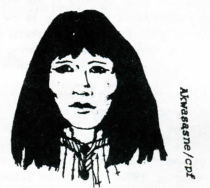Maquiladoras
The situation of women industrial worlfers in l\/lexican l\/lultination brancfi plants or "maquiladoras"has been documented by anthropology graduate student Maria Patricia Fernandez. The following extracts are taken from "A profile of Factory Workers in Cuidad Juarez" research prepared for the Centra de Estudios Sociologicos, Colegio de Mejico, April 1979.
Kika may have dispaired at her difficulty to firxl a job in an environment where the only viable employment opportunities were geared to women almost exclusively. But the apparent paradox in which she found herself obscured many of the advantages of relocation from the point of view of multinational corporations. Women who are forced to compete against one another for a limited number of jobs turn out to be efficient and docile workers when competition occurs in a social milieu devoid of occupational opportunities for men. It is not enough to state that multinational corporations seek relocation in underdeveloped areas such as the Mexican border in order to benefit from broad wage differentials, longer working weeks and increased productivity. In other words, it is not sufficient to explain the internationalization of capital investments in terms of the corporate search for cheap labor. "Cheap labor" is too broad a category to explain the subtleities of what actually occurs. To gain better understanding of this phenomenon it is necessary to go a step further and to examine the manner in which gender as an employment criterion affects labor supply. It is important to realize, for example, that unemployment and underemployment rates have increased in border municipalities since the maquiladora program was implemented (in 1960 the proportion of unemployed among the economically active population in the border municipalities was 2.4% while in 1970 it was 4.17% ). While it is true that such an increase is partly due to uncontrolled migration to cities like Ciudad Juarez, it is also related to the failure of maquiladoras to incorporate men into their operations. The reasons for this
are economic, ideological and political.
"We hire mostly women because they are more reliable than men; they have finer fingers, smaller muscles and unsurpassed manual desterity. Also, women don't get tired of repeating the same operations nine-hundred times a day". Such was the explanation offered by Kika's personnel manager when asked why 90% of the plant's workers are women. His was a lucid articulation of the ideology that justifies the employment of women (particularly young women) in low-paying assembly operations with reference to presumed biological and emotional differences between the sexes.
After four years of tedious labor at the plant, Kika admits she is exhausted. More discouraging than monotony is the realization that promotions are hard to come by and wages are forever shrinking. Since she began work, she has put in, at least forty-eight hours each week for an average of U.S. 58 an hour. She has worked from 6.30 A.M. to 3.15 P.M. on week days and from 6.30 A.M. to 11.30 A.M. on Saturdays. From Monday to Friday she, like the rest, is allowed ten minutes in the morning to have breakfast and thirty minutes in the afternoon to eat lunch.
Kika must go on working because she has no choice. She longs for the day when she will be able to get married, leave the work force and have a home of her own. Being a member of a generation of female factory workers that is barely a decade old, Kika does not see herself as a member of the proletariat, but as a potential wife and mother. Novels and soap operas have instilled and reflect romance in her mind. But marriage is a hazardous prospect in a context characterized by economic constraints that keep men in her circle from performing their traditional role as providers.
To promoters of the In-Bond Manufacturing Program, maquiladoras may represent a success, but Kika knows she lives in a painful bind. And is that not what the terms underdevelopment and dependency mean in a most precise manner? Cut from their abstract embellishements they describe a social reality in which persons like Kika and the members of her family live.
Definition of Maguiladora
Article 321 of the Mexican Customs Code defines a maquiladora (also known as "twin plant", "inbond plant", or "runaway plant") that which
1. with temporarily imported machinery, whatever the manufacturing costs, exports its total production or,
2. with a permanent industrial plant installed to supply the domestic market, directs part or all of its production for exportation, and the direct manufacturing costs of its
product at the time of exportation does not reach 40% .
Bustamante.
"Maquiladoras: New Face of International Capitalism on Mexico's Northern Frontier. 1976.


